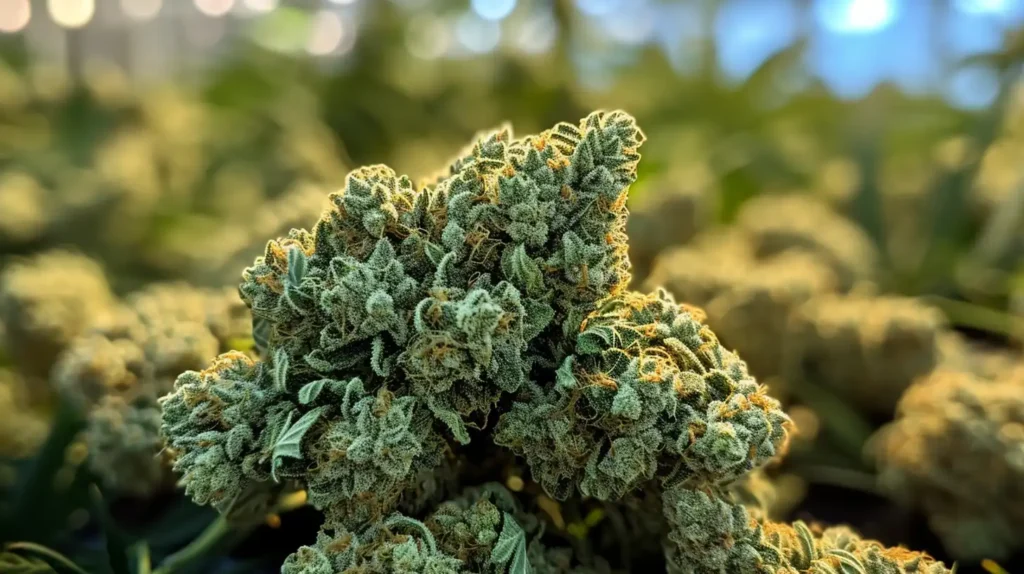Hybrid Strains Cannabis Exploration
In my journey with hybrid strains, I’ve delved deep into the fascinating world of cannabis cultivation and consumption. Hybrid strains, a combination of two or more distinct cannabis varieties, offer a diverse array of effects and flavors that have captivated enthusiasts and connoisseurs alike. This article aims to provide a comprehensive exploration of hybrid strains, from their origins and creation to their evolution and popularity in the modern era.
We’ll start by uncovering the intriguing process of how hybrid strains are created, shedding light on the meticulous breeding techniques that have given rise to an extensive spectrum of hybrid varieties. We’ll delve into the different types of hybrid strains, each with its unique genetic composition and therapeutic properties.
The evolution of hybrid strains spans decades, from their humble origins to their meteoric rise in the 20th century and the profound impact of legalization on their proliferation. By understanding this evolution, we gain valuable insights into the cultural and regulatory forces that have shaped the hybrid strain landscape.
We’ll explore some of the most popular hybrid strains today, including renowned names like Blue Dream, Girl Scout Cookies, Gorilla Glue, Pineapple Express, and OG Kush. By examining the characteristics and experiences associated with these strains, readers will gain a deeper appreciation for the diversity and complexity of hybrid genetics.
Looking ahead, we’ll contemplate the future of hybrid strains, discussing the potential innovations and challenges that lie on the horizon. By addressing the benefits and risks of hybrid strains, we hope to provide a balanced perspective on their role in the evolving cannabis industry.
So, join me on this captivating journey through the history, present, and future of hybrid strains, as we uncover the secrets and stories behind these remarkable cannabis creations.
Key Takeaways:
- Hybrid strains are a combination of two different cannabis varieties, resulting in unique and potent effects.
- They have been around for centuries, but their popularity and availability have significantly increased in recent years due to legalization.
- The future of hybrid strains is promising, with continued advancements and potential benefits for both medical and recreational users.
My Journey with Hybrid Strains
My journey with hybrid strains has been a fascinating exploration of the evolution, breeding techniques, and diverse effects of modern hybrids, paving the way for future developments and innovations in the cannabis industry.
Hybrid strains have provided me with a nuanced understanding of the interplay between different cannabis varieties, offering a tapestry of aromas, flavors, and effects. The genetic diversity present in hybrids often results in a wide spectrum of experiences, ranging from calming and relaxing to energizing and uplifting.
Through careful crossbreeding, hybrid cannabis has ushered in a new era of customization, tailoring strains to specific user preferences and medicinal needs. This innovation has redefined the landscape of the cannabis industry, enticing both connoisseurs and medical users alike.
What Are Hybrid Strains?
Hybrid strains, derived from the cannabis plant, represent a blend of genetic characteristics and molecular traits achieved through advanced breeding techniques and molecular perspectives, encompassing the intricate interplay of cannabinoids, terpenes, and genetic stability.
How Are Hybrid Strains Created?
Hybrid strains are created through meticulous breeding programs, leveraging genomic transcriptomic data and marker-assisted breeding techniques to integrate desirable traits from cannabis hybrids, landrace strains, and heirloom varieties, often utilizing SNP markers for precision.
These breeding programs involve careful selection of parent plants with specific characteristics, followed by controlled cross-breeding to create offspring with the desired traits.
Genomic transcriptomic data is utilized to identify genes responsible for the traits of interest, enabling breeders to make informed decisions in the selection process. Marker-assisted breeding further enhances the efficiency by allowing precise identification and incorporation of the desired genetic markers.
What Are the Different Types of Hybrid Strains?
The different types of hybrid strains encompass a spectrum of Sativa and Indica influences, showcasing hybrid vigor and genetic diversity, leading to F1 hybrids with diverse effects and cultivation challenges, influenced by the interplay of sex chromosomes.
Hybrid strains blend the best qualities of Sativa and Indica, resulting in a harmonious fusion of physical and cerebral effects. It’s fascinating how these hybrids inherit distinct traits from their parent strains, creating a unique experience for consumers. With such genetic diversity, hybrid strains can be bred to thrive in a variety of growing conditions, offering a diverse range of aromas, flavors, and cannabinoid profiles.
The Evolution of Hybrid Strains
The evolution of hybrid strains is intricately intertwined with the historical context, genetic basis, and molecular perspectives, adapting to changing legal frameworks and taxonomic classifications while advancing our understanding of genetics in cannabis.
Hybrid strains have undergone a remarkable evolution, beginning with the intentional crossbreeding of different cannabis varieties to combine their unique attributes. Throughout history, this genetic diversification process has been driven by both intentional and unintentional selection, influencing the molecular landscape of hybrid strains. The advent of molecular breeding techniques has further revolutionized the development of hybrids, allowing breeders to target specific traits and enhance genetic stability.
The legal framework surrounding cannabis has played a pivotal role in shaping the development and distribution of hybrid strains. As regulations continue to evolve, breeders and cultivators must navigate complex legal landscapes, impacting the availability and diversity of hybrid varieties. This intersection of genetics, historical context, and legal dynamics underscores the complexity of hybrid strain evolution.
The Origins of Hybrid Strains
The origins of hybrid strains can be traced back to influential varieties such as Original Haze, Skunk # 1, and the pioneering work of the Haze Brothers, marking a defining phase in molecular breeding within the cannabis industry and historical context.
Original Haze, a sativa-leaning strain, gained notoriety for its energetic, euphoric effects, and contributed immensely to the development of hybrid strains with its distinct lineage and potency. Skunk # 1, known for its robust genetics and pungent aroma, played a pivotal role in the hybridization process, influencing the creation of numerous award-winning hybrids.
The Haze Brothers laid the groundwork for modern hybridization through their dedication to capturing the best traits of cannabis plants, resulting in a genetic basis that underpins the diversity of hybrid strains available today. Their collaborative efforts and innovation in breeding techniques advanced the cannabis industry, shaping the landscape of hybrid strains for generations to come.
The Rise of Hybrid Strains in the 20th Century
The 20th century witnessed the rise of iconic hybrid strains like OG Kush, Northern Lights, and Blueberry, showcasing genetic stability, diverse phenotypes, and a molecular perspective that revolutionized modern breeding techniques.
These legendary hybrids have left an indelible mark on the cannabis industry, with their unique genetic makeup providing a solid foundation for numerous modern cultivars. OG Kush, celebrated for its pungent aroma and potent effects, has become a cornerstone in the development of new strains, influencing the broader hybrid landscape.
On the other hand, Northern Lights, renowned for its resilience and quick flowering time, has been integral in breeding programs, contributing its robust attributes to create hybrids with enhanced vigor and adaptability.
Similarly, Blueberry, with its luscious fruity flavors and relaxing properties, has been a sought-after genetic asset, contributing to the creation of diverse phenotypes that cater to varying consumer preferences.
The Impact of Legalization on Hybrid Strains
The impact of legalization on hybrid strains has reshaped their utilization, opening avenues for recreational use, exploring new medical implications, and setting the stage for future developments within a changing legal framework and molecular perspective of genetic basis.
As legalization continues to evolve, previously underground hybrid strains have entered mainstream markets, leading to a surge in recreational consumption and experimentation. This shift in legal status has not only expanded the accessibility of these hybrid strains but has also propelled their exploration in medical research to uncover potential therapeutic benefits. With changing regulations and increased acceptance, the future promises advancements in the genetic understanding and molecular profiling of hybrid strains, signaling exciting prospects for targeted cultivation and potentiated effects.

The Most Popular Hybrid Strains Today
The most popular hybrid strains today include iconic varieties such as Blue Dream, Girl Scout Cookies, Gorilla Glue, Pineapple Express, and the timeless OG Kush, captivating enthusiasts with their diverse effects and rich genetic heritage.
These strains are cherished for their ability to provide a balanced and enjoyable experience, catering to both novice and seasoned users alike. Blue Dream’s uplifting and euphoric effects make it a favorite for daytime use, while Girl Scout Cookies’ sweet and earthy aroma combined with its relaxing effects have gained widespread acclaim.
The strength and resilience of Gorilla Glue have solidified its place in the cannabis community, offering users a powerful high that soothes both body and mind. Pineapple Express has become synonymous with energizing and creative effects, earning a loyal following among those seeking inspiration.
Not to be overlooked, the legendary OG Kush continues to reign as a cornerstone of hybrid varieties, renowned for its potent and calming influence, making it a staple in the cannabis world.
Blue Dream
Blue Dream stands as a quintessential hybrid strain renowned for its diverse effects, presenting unique cultivation challenges and embodying the essence of modern molecular breeding techniques.
With its harmonious balance of Sativa and Indica genetics, Blue Dream offers a euphoric and uplifting experience accompanied by a gentle body relaxation. This makes it a popular choice among cannabis enthusiasts seeking a well-rounded high.
Its hybrid nature also results in a challenging cultivation process, requiring careful attention to both Sativa and Indica growing techniques. The influence of modern molecular breeding has enhanced Blue Dream’s potency and stability, contributing to its widespread popularity in the cannabis community.
Girl Scout Cookies
Girl Scout Cookies has garnered acclaim as a hybrid strain, resonating with both recreational and medical users due to its genetic stability, distinct phenotypes, and versatile applications.
The distinctive combination of OG Kush and Durban Poison has resulted in a strain known for its balanced effects, often inducing feelings of euphoria and relaxation, while also offering potential relief from chronic pain, anxiety, and nausea.
Its robust genetics have solidified its reputation for consistency, with growers appreciating its resilience and ability to produce high yields. The thin mint and platinum GSC phenotypes showcase different flavor profiles and potency levels, catering to varied preferences among consumers and patients.
Gorilla Glue
Gorilla Glue has emerged as a prominent hybrid strain, embodying the essence of modern hybrids through innovative breeding techniques, showcasing genetic stability and a molecular perspective that sets it apart.
The cultivation of Gorilla Glue involves a strategic fusion of carefully selected parent strains, each contributing specific genetic traits to create a well-balanced and potent hybrid. Its genetic stability ensures consistent characteristics and reliable performance across different batches, distinguishing it as a reliable choice among hybrid enthusiasts.
From a molecular perspective, Gorilla Glue exhibits a complex combination of cannabinoids and terpenes, resulting in a unique sensory experience that captivates consumers. This intricate molecular profile contributes to its distinct aroma, flavor, and effects, making it a sought-after option in the modern cannabis market.
Pineapple Express
Pineapple Express has captured attention as a hybrid strain, embodying genetic stability and the outcomes of meticulous molecular breeding, offering diverse applications for both recreational use and medical implications.
This cultivar boasts a unique blend of parent strains, resulting in a well-balanced THC/CBD profile that has gained popularity among cannabis enthusiasts seeking a euphoric yet soothing experience. Its genetic stability contributes to consistent cannabinoid and terpene profiles, ensuring a reliable and predictable user experience.
Pineapple Express’s molecular breeding process has harnessed the desirable traits of its parent strains, emphasizing fruity aromas and flavors with hints of tropical citrus, adding an enticing sensory dimension to its appeal.
OG Kush
OG Kush stands as a timeless hybrid strain, embodying genetic stability, the fruits of innovative breeding techniques, and a molecular perspective that has left an indelible mark on the cannabis industry.
Its reputation for delivering a euphoric, creative high combined with its distinct earthy and pine aroma has captivated cannabis enthusiasts for decades. The genetic stability of OG Kush has made it a sought-after strain for breeders looking to incorporate its robust characteristics into new hybrids, contributing to its enduring influence on the market.
As breeders have carefully honed its genetic traits, OG Kush has become a cornerstone in the development of other widely cherished strains. The meticulous breeding techniques behind OG Kush has paved the way for advancements in hybrid strains, enriching the diversity offered to consumers seeking specific effects and flavors.
The Future of Hybrid Strains
The future of hybrid strains holds promising prospects for continued development, marked by innovative breeding techniques, adaptations to the legal framework, and a deeper understanding of the molecular perspective and genetic basis shaping the evolution of cannabis hybrids.
In the realm of hybrid strains, there is an ongoing surge of creativity in leveraging advanced technologies for breeding techniques. Researchers and horticulturists are diving into cutting-edge methods to carefully select and crossbreed desirable traits, aiming to achieve optimal potency, flavors, and therapeutic properties in hybrids.
The ever-evolving legal framework surrounding cannabis cultivation and consumption is shaping the trajectory of hybrid strains. As legislations become more progressive, allowing for greater freedom in experimentation and marketing, it opens doors for cultivators to explore new pathways in hybrid development.
With a deeper understanding of the molecular perspective and genetic makeup influencing hybrid traits, scientists are exploring precise genetic modifications and biotechnological interventions, promising a future of even more diverse and tailored hybrid varieties.
What Can We Expect from Hybrid Strains in the Future?
The future of hybrid strains promises advancements driven by a deeper molecular perspective, refined breeding programs, and the integration of genomic transcriptomic data, bolstered by the precision of marker-assisted breeding techniques.
Considering the growing understanding of the molecular aspects of hybrid strains, there is immense potential to leverage this knowledge for creating new varieties that are more resilient, productive, and adaptive to changing environmental conditions. The application of genomic transcriptomic data can offer invaluable insights into the genetic makeup of hybrid strains, enabling breeders to identify and select for specific traits with unprecedented precision. This, in turn, can accelerate the development of targeted breeding programs aimed at producing hybrids with enhanced characteristics, addressing global agricultural challenges, and ensuring food security.
The Potential Benefits and Risks of Hybrid Strains
Assessing the potential benefits and risks of hybrid strains reveals their diverse effects, multifaceted applications for recreational use and medical implications, the significance of genetic stability, and the inherent cultivation challenges they present.
Hybrid strains, a genetic blend of indica and sativa varieties, often offer an ideal balance of the relaxing and uplifting attributes of both parent strains. This unique combination can cater to different consumer preferences, providing a wider range of sensory experiences and potential therapeutic effects.
The genetic diversity within hybrid strains raises concerns about genetic instability, potentially leading to inconsistent phenotypes and unpredictable cultivation outcomes. The cultivation of hybrids demands meticulous attention to environmental factors and nutrient management to ensure optimal growth.
Frequently Asked Questions
What exactly are hybrid cannabis strains?
Hybrid strains are a combination of two or more cannabis strains, resulting in a new strain with characteristics from both parent strains. These strains are created through crossbreeding and are often designed to provide a unique combination of effects.
How did hybrid strains come to be?
Hybrid strains were first developed in the 1970s when breeders started experimenting with different combinations of cannabis strains in an effort to create new and more potent varieties. This experimentation eventually led to the creation of the first hybrid strains.
What is the significance of hybrid strains in the cannabis industry?
Hybrid strains have played a significant role in the cannabis industry, as they have allowed for the development of new and more diverse strains with specific effects. This has also allowed for a wider range of options for medical patients.
How have hybrid strains evolved over time?
Since their initial development, hybrid strains have continued to evolve and become more sophisticated. Breeders now have access to a wider variety of strains and techniques, allowing them to create even more unique and potent hybrid strains.
What are some popular hybrid strains?
Some popular hybrid strains include Blue Dream, Girl Scout Cookies, and White Widow. These strains have gained popularity due to their unique effects and wide availability in the market.
Are there any potential drawbacks to hybrid strains?
As with any cannabis strain, there are potential drawbacks to using hybrid strains. These can include side effects such as dry mouth and anxiety, as well as potential negative interactions with other medications. It is important to always use hybrid strains responsibly and consult with a healthcare professional if you have any concerns.
Join our Hybrid Strains Cannabis Exploration newsletter to journey through the dynamic world of hybrid cannabis. Discover the intricate breeding processes, famous strains like OG Kush and Pineapple Express, and the evolution from their origins to modern popularity. Subscribe now for in-depth insights into hybrid strain genetics, their therapeutic properties, and future trends. Whether you’re a cannabis enthusiast or a newcomer, our newsletter offers a comprehensive view of the diverse and fascinating world of hybrid cannabis strains.






